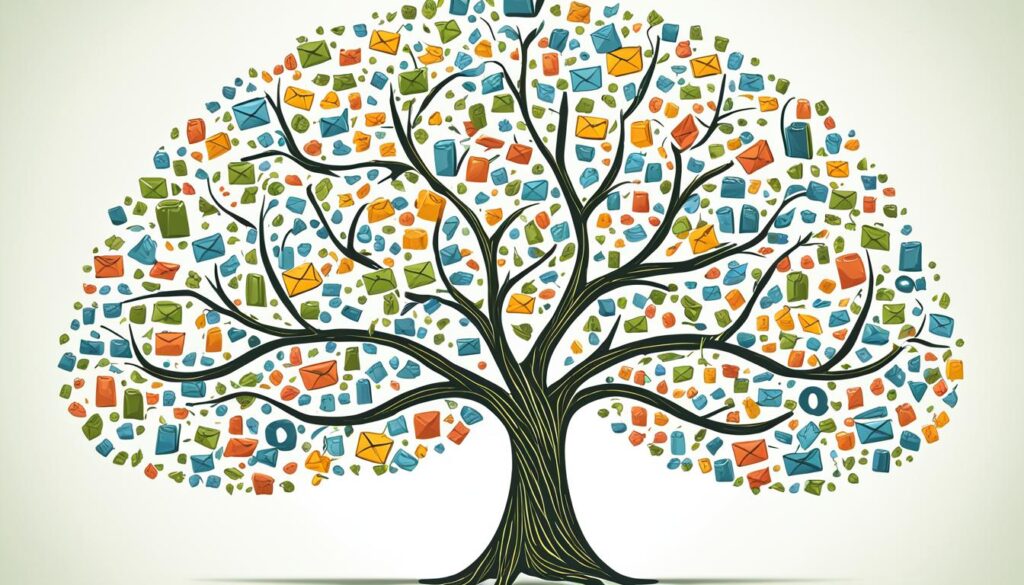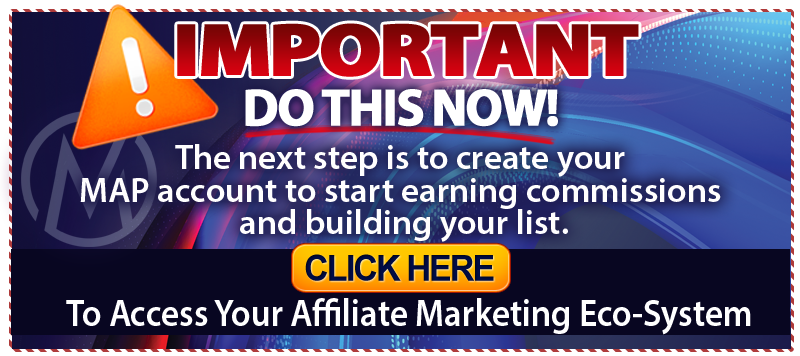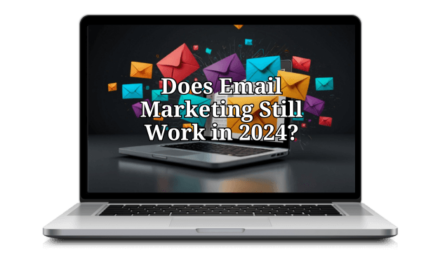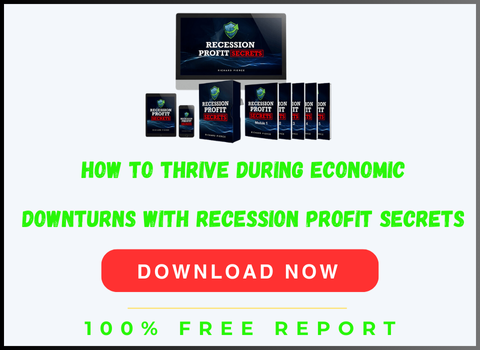For every $1 spent on email marketing, you can earn back $42. This awesome fact highlights email marketing’s value in today’s digital world. As someone who supports email marketing, I’ve seen its growth. Yet, its main aim – to connect, engage, and turn readers into customers – remains the same. Crafting successful emails is an art. It combines both science and creativity to make your email efforts count towards your goals.
What are the 3 types of email marketing? Email marketing isn’t just about sending lots of emails. It’s about knowing the different types and using them right alongside your marketing plans. You might send promotional emails to spark interest, informative newsletter emails to keep in touch, or targeted lead nurturing emails. The key is to match your message with what your audience needs and your company’s goals. Let me walk you through these main campaign types that can boost your brand and profits.
Key Takeaways
- Understanding different email campaign types is crucial for maximizing ROI in digital marketing.
- Promotional, newsletter, and lead nurturing emails stand as pillars for effective email marketing.
- Personalization and relevance are key to the success of any email marketing strategy.
- Investing in the best email marketing types leads to better engagement and customer retention.
- A mix of different types of email marketing campaigns can optimize your brand’s outreach.
Delving into Email Marketing: Understanding Its Impact
Exploring email marketing strategy shows how key a tailored approach is. It raises brand awareness. With many marketing emails sent daily, making yours stand out is tough. To be effective, you must understand email types and use methods that grab attention.
It’s vital to check how well your marketing emails perform. A low click-through rate (CTR) might mean your content doesn’t match what your audience wants. Not every marketing email will work. Success depends on making a personal connection. Knowing the difference between promotional, newsletter, and lead nurturing emails is crucial.
- Promotional emails announce new products or deals to spark quick action.
- Newsletter emails provide regular updates and build your brand’s story.
- Last, lead nurturing emails help build relationships and guide potential customers further.
To really reach your audience, you need to understand what they want. Sending the right email at the right time to the right person matters. This precision can make the difference between a forgotten email and a strong marketer-customer bond.
Effective email marketing campaigns are not only measured by the immediacy of their success but also by their enduring impact on brand perception and customer engagement.
Different emails can significantly raise brand awareness if done carefully. Learning about email marketing reveals that a thoughtful strategy not only boosts CTRs but also strengthens a brand’s digital presence.
Fostering Brand Engagement Through Promotional Emails
As someone who builds strong customer bonds, I use promotional emails to spark interest in my product or service. Each campaign gives me a chance to connect with my email list. I announce new offerings and celebrate special events unique to our brand. These strategic emails encourage action and grow brand loyalty.
In my view, a top-notch promotional email is more than just news. It invites people into our brand’s world. These emails stand out amidst heaps of others. They mix business with community, especially during special events key to our customers.
“Every promotional email should be a mosaic of persuasive language and striking visuals, harmoniously blended to showcase your unique selling proposition clearly and compellingly.”
Here’s how I boost engagement through promotional emails:
- Using analytics to shape a marketing strategy around what our audience likes.
- Highlighting promo offers too good for our audience to ignore, like discounts and exclusives.
- Getting ready for big retail events all year, so our email list can’t wait to hear from us.
- Making sure our visual and textual messages combine well to tell stories about our product or service, turning features into benefits.
I design every part of the email, from subject lines to calls-to-action, to make lasting connections. This approach helps stand out against daily digital clutter.
Promotional emails are key to my marketing strategy. Mastering them involves more than creation; it’s also seeing how customers respond. I always aim to improve, create anew, and capture attention with each email I send.
Cultivating Relationships with Newsletter Emails
As a small business, sending newsletter emails is key to staying connected. These emails let me send company updates, blog content, and special promotions directly to my customers. It’s a way to keep in touch with the people who support my business.
Marketing automation makes sending newsletters easy and efficient. Even when business gets busy, automation sends out my newsletters on time. This keeps my audience engaged and well-informed.
- Personalized content that resonates with my readers
- Updates on new products or services relevant to their interests
- Education on industry trends that positions my brand as an authority
- Exclusive offers that reward loyalty and invite further engagement
Cultivating a relationship with your customer base is an ever-evolving journey that thrives on consistency, relevance, and personal touch. Newsletter emails are not just about selling—they’re a platform for storytelling, sharing knowledge, and building a community around your brand.
For any small business wanting to boost customer relationships, newsletter emails are crucial. They do more than just update your audience. They turn casual readers into active participants in your brand’s journey.
Converting Prospects Into Customers with Lead Nurturing Emails
In my journey with digital marketing, I’ve learned the importance of lead nurturing emails. They are crucial in turning potential leads into devoted customers. These aren’t just any emails. They’re a series designed to educate and influence prospects through the marketing funnel.
The Role of Automated Sequences in Customer Journey
Automated email sequences work wonders because they’re timed well and personalized. This makes a big difference in the customer journey. Imagine this: once someone shows interest by subscribing, they’re smoothly moved into a nurturing path. This path changes based on how they interact.
Targeted Content for Maximizing Lead Conversion
Each email in the series is built to add value. It might share knowledge, professional insights, or an irresistible offer. The goal is to make every interaction bring the prospect closer to a purchase. It shows the power of careful lead nurturing in improving sales numbers.
- Introduction to the product or service
- Educational content related to the product
- Testimonials and success stories
- Special offers or incentives to purchase
- Follow-up and feedback requests post-purchase
Through precise, targeted content, lead nurturing not only boosts sales but also fosters trust and credibility. These are vital for any strong, lasting business relationship.
What Are The 3 Types of Email Marketing Strategies
In my digital marketing journey, I’ve learned how crucial it is to grasp the range of email marketing. This knowledge helps in nurturing audience relationships and widening your brand’s presence. Using different email marketing strategies makes sure we reach every potential customer in the sales funnel. This insight into the leading email marketing types boosts engagement and success.
Inbound Email Marketing: Engaging Your Subscribers
Inbound email marketing is about connecting with a specific group of subscribers. These folks have shown interest in your brand and opted to engage. It’s the perfect chance to build their loyalty with emails that match their needs. The key to inbound email marketing success is providing value that fits each subscriber’s brand journey.
Outbound Email Marketing: Reaching New Audiences
On the other hand, outbound email marketing targets a larger audience. This proactive approach doesn’t wait for people to show interest first. Its aim is to spread the word about your brand and pique the curiosity of new potential customers. It encourages them to subscribe and begin their journey with your brand.
Mixed Approach: Combining Inbound and Outbound Strategies
Using both inbound and outbound strategies together often works best. With the mixed approach, I cater to committed followers and also reach new people. This method mixes the personal touch of inbound with outbound’s broad scope. It’s a sign of savvy, contemporary email marketing techniques.
Gathering Insights with Strategic Survey Emails
In the realm of email marketing, survey emails are a powerful asset. They not only aid in data collection but also boost customer service. Sending out survey emails is like opening a dialogue with our customers. It shows we value their opinions.
Gathering feedback is crucial for a business to connect with its audience. By using survey emails, we make our clients feel listened to and appreciated. This builds brand loyalty.
Feedback from surveys gives us valuable insights. It helps refine our products or services with feedback collection playing a key role. Analyzing responses helps us understand what customers like or don’t. This shapes our future strategies.
- Survey Emails: Crafting engaging questions to get honest and useful feedback.
- Email Marketing: Using automated tools to send surveys and track how people engage with them.
- Feedback Collection: Looking at what people say to make our products better and shape our marketing.
- Customer Service: Utilizing survey insights to proactively solve issues and make customer experiences more personal.
- Data Collection: Using analytics to make sense of survey answers and make informed decisions.
Through improving customer experiences, I’ve learned how crucial survey emails are. They keep us connected with our customers. They turn feedback into a foundation for growth in email marketing. Responses represent real thoughts from real people.
Celebrating Customer Milestones for Lasting Loyalty
In my work as a marketer, I’ve seen how milestone emails boost customer loyalty. These personalized emails show a brand’s dedication to customer appreciation and increase brand engagement. Celebrating events like anniversaries or birthdays with customers is more than just nice. It’s a strategy that helps keep your customers coming back and feeling positive about your brand.
Our strategy with milestone emails is about honouring the customer’s journey with the brand. Each email is crafted to connect with the person receiving it. They’re not just standard well-wishes; these emails offer special deals or discounts. These deals are chosen based on the customer’s past actions or likes. This method does more than just mark a calendar date; it strengthens the relationship between the customer and the brand.
But why bother with milestone emails? It comes down to the importance of feeling recognized. Being acknowledged by a brand makes the idea of customer loyalty real. We all want to stick with brands that appreciate us. This feeling boosts ongoing interactions with the brand. Here’s what I do to make sure my milestone emails are a hit:
- Collect customer data to find important dates and likes.
- Write a personalized email that celebrates and offers true value.
- Analyze how well these emails do and improve for next time.
The aim is to celebrate your customers in a genuine way. This makes them feel like they’re part of the brand’s big family. It’s great for brand engagement. It also builds a community feeling that keeps customers wanting to stay.
From my view, milestone emails are more than a marketing move; they’re a thank you. And when customers feel valued, they repay brands with something much bigger than a one-time buy: their continued loyalty.
Creating a Positive First Impression with Welcome Emails
When I create a welcome email, it’s more than a simple message. I’m starting what I hope becomes a lasting connection with a new subscriber. The first email is critical. It shapes the first impression and influences future interactions with my brand. A well-crafted welcome email builds trust and is key to an email marketing strategy.
Welcome emails are crucial for beginning subscriber engagement. I make sure these emails reflect my brand’s values and vision. Using a personalized approach shows subscribers they’re valued beyond their email address. I aim to send these emails within 24 hours of getting the subscription to capture their interest.
Setting clear expectations is important too. I tell subscribers what they’ll get and how often, to be upfront. Adding exclusive perks or insights as a thank you is something I like to do. Even simple rewards, like unique content or a one-time discount, are effective.
Remember, the power of a welcome email transcends the mere act of saying hello; it’s the opening note of a symphony that plays on the principles of reciprocity, trust, and mutual benefit.
- Making an indelible first impression
- Building trust from the get-go
- Tailoring the experience with personalization
- Clarifying content and frequency expectations
- Using timely delivery to enhance open rates
- Fostering effective subscriber engagement
Looking back at the welcome emails I’ve sent, they’re not just introductions. They are vital to starting a journey together. In this journey, trust and clear communication lead to a strong subscriber relationship.
Amplifying Offers Through Dedicated Emails
In email marketing, using dedicated emails is key for highlighting special deals. My method focuses on making standalone emails that really grab the audience. I make sure each one has a strong call to action.
Structuring Standalone Sends for Promotion-Specific Purposes
Creating a standalone email starts with picking the right email templates. They need to look good and appeal to the right people. I add a straightforward CTA that turns readers into doers. My approach is all about sharing the unique offer in a way that’s exciting and clear.
Tracking Metrics and Measuring Success of Single Sends
Measuring success in an email campaign is crucial. Using email automation tools, I track everything from how many open the email to who actually takes action. This info helps me make better campaigns in the future. It proves that focusing on data helps achieve better results.
- Open Rate: A measure of how many have taken the initial step to engage with the email’s content.
- Click-Through Rate (CTR): Reflective of the percentage who have interacted with the CTA, leading them closer to the end goal.
- Conversion Rate: The ultimate indicator of effectiveness, denoting action taken that aligns with the email’s purpose.
I believe combining a smart email strategy with careful analysis makes marketing work well. It’s a mix of creativity and numbers. This is how I create messages that don’t just land in inboxes, but also touch people’s hearts and minds.
Re-Engaging Inactive Users with Persuasive Re-engagement Emails
As a digital marketer, I focus on creating an email marketing campaign. My goal is to boost subscriber engagement. It involves more than just sending emails; it’s about rekindling interaction. This makes crafting enticing re-engagement emails a key strategy.
Rekindling a bond with a subscriber can be a transformative moment for an email marketing campaign.
I use email automation to craft messages that reawaken interest. These messages are not just generic emails. They are personalized invitations that remind users why they loved our service.
- Promotional updates to lure back with temptations of what’s new
- Curated content that reminds them why they subscribed in the first place
- Invitations to provide feedback or preferences, enhancing their sense of involvement
With marketing automation, managing this process becomes easier. It also helps track results and make improvements. Seeing the increase in engagement from these messages is rewarding. It shows that even inactive subscribers can become active again.
The journey from inactive to active is enlightening. Re-engagement emails are not just about getting opens. They’re about restoring relationships and showing the value of our brand. It’s about meaningful connections that resonate on a deeper level.
Recovering Sales Opportunities with Abandoned Cart Emails
I’ve learned that abandoned cart emails are key in email marketing. They remind customers who didn’t finish buying to come back. Done right, these emails can turn almost-lost sales into real purchases.
These emails make people remember what they left in their carts. They play a big part in keeping customers and making more sales. Figuring out why people leave their carts and talking to them about it can really help.
Every abandoned cart is a story untold; a purposefully crafted email can bring that narrative to a satisfying conclusion, with the checkout process as its final chapter. – A seasoned Email Marketer
This is how I use abandoned cart emails:
- Finding out why people don’t finish buying and sending the email when they’re still deciding.
- Making the email personal, showing customers the items they forgot and reminding them why they picked them.
- Offering special deals like discounts or free shipping, but making sure the offer feels special and urgent.
In improving email marketing, I’ve seen these emails do more than just boost sales. They’re about making the shopping experience better. They show you get your customers, offering them value that’s more than just a sale. Sending these emails means we’re trying to connect with our customers on a deeper level, beyond just selling.
Conclusion
In my journey through digital marketing, I’ve watched email marketing grow. It has become a powerful tool for businesses. By mixing promotional, newsletter, and lead nurturing emails, you can keep customers engaged. Each type works together to keep customers coming back and helps businesses succeed.
I’ve seen first-hand how a great marketing email can make a big impact. Engagement emails keep the conversation going and make the brand feel more personal. It’s tricky, but getting it right can really help businesses grow, no matter their size.
Effective email marketing isn’t just about sending emails. It’s about building relationships and sharing stories. A good email campaign shows what a brand is all about. It also shows off their marketing skills and helps them reach more people. So, understanding different types of emails is essential for digital marketing success.
Frequently Asked Questions
What are the 3 main types of email marketing?
Email marketing comes in three main types. Promotional emails advertise products or services. Newsletter emails keep subscribers updated with content. And, lead nurturing emails help potential customers move through the sales funnel with targeted content.
How can email marketing impact a business’s digital marketing strategy?
Email marketing offers a direct line to subscribers. It’s great for promoting products and engaging customers. This helps drive conversions, increase brand awareness, and supports a unified marketing approach.
What content is typically included in promotional emails?
Promotional emails pack in the latest product info, special deals, and event invites. Their goal is to spark action. This could be buying something or attending an event, highlighted by a strong CTA. (Call to Action)
Why are newsletter emails important for small businesses?
Newsletter emails keep small business customers engaged. They share updates, blog posts, and support marketing. This keeps the brand in customers’ minds steadily.
What is the difference between inbound and outbound email marketing?
Inbound marketing is about engaging interested audiences with preferred content. Outbound reaches wider, sometimes without permission, aiming to find new leads and spread brand awareness.
What are milestone emails and how do they benefit customer retention?
Milestone emails celebrate special customer moments, like anniversaries or birthdays. Personalized messages strengthen customer bonds. This boosts engagement and keeps them coming back.
Why are welcome emails crucial in email marketing?
Welcome emails introduce the brand-subscriber relationship. They make a great first impression, building trust. A well-crafted welcome email can up engagement and foster long-term loyalty.
